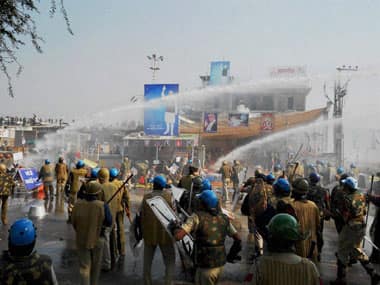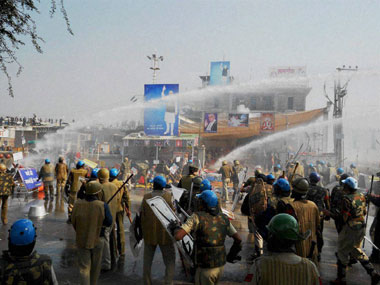A side-story in the violent face-off between Sant Rampal and the Haryana police is the collateral damage suffered by the mediapersons assembled outside his ashram at Barwala. One report says that around 70 newspersons and camera crew were injured in an “unprovoked” police assault on them on Tuesday (18 November), when the police tried to break the cordon around the godman. Seventy injuries to media persons — even if the numbers seem a bit excessive — cannot clearly have been mere heat-of-the-moment accidents. While we will wait for a police inquiry report to tell us why this happened, it exposes serious flaws in the way men in uniform handle the media and how the media itself behaves in such situations. [caption id=“attachment_1813197” align=“alignleft” width=“380”]  Police try to disperse crowds near Rampal’s ashram. PTI[/caption] Without prejudging what happened specifically at Barwala, where Rampal was finally arrested on Wednesday night (19 November) after his followers pressed the unfollow button, it is clear that neither armed personnel nor the media have a sensible code of behaviour when pulled together to a combat zone where there may be violence, injuries and casualties. India’s police forces do not seem to have a standard operating procedure (SOP) for such situations, with clear dos and don’ts for the media, and a strategy for their exclusion from zones where shots may be fired and there is danger of death and/or injury. Nor do the police have rules on how to deal with intrusive media by offering updates while a sensitive operation is on. In such a situation, it is not unlikely that poorly trained police personnel end up attacking newsmen who, they fear, may be filming violent scenes that may be played on TV instantly, jeopardising ongoing operations. There is also no guideline on what can be broadcast and what cannot. It is high time we had a well-explained and well-understood code for the media when a siege is mounted, or there is a terrorist incident, or bombs have been set off, or hostages have been taken in a terror-related incident. We know all the likely scenarios since we have seen them all in India. So drawing up an SOP for each such situation and explaining it to the media cannot be difficult. Without such a go-no-go code for the media, anti-terror or police combat actions have invariably been handled haphazardly — as the Barwala attack on journalists and cameramen showed. In the 26/11 Mumbai terror attacks, live TV broadcasts actually aided the Pakistani-based handlers of the Lashkar-e-Toiba terrorists holed up inside the Taj, Chabad House and Trident Hotel to direct the killing of more people. It also gave the handlers the ability to provide long-distance psychological support and motivational advice to the killers. The police failed to maintain camera crews at a sufficient distance once it was clear that terrorists had taken over the buildings. As Editor of DNA newspaper at that time, in recall that one of my reporters actually found her way into the Taj after it became known that terrorists had taken over. She escaped a bit later when she realised what she had gotten into, but she spent much of her time inside the hotel quivering in fear. In the 1999 Kandahar Indian Airlines hijack, TV was constantly playing angry video interviews with the relatives of the people on the plane, demanding that the terrorists’ demands be met so that their near ones could come home safe. This was one factor that weakened the Vajpayee government’s ability to consider other options for rescue. Contrast that with how the west is handling the repeated beheadings of its people by ISIS. The media is doing nothing to give the terrorists encouragement where they can continue with their murderous blackmail. In the July 2011 bomb blasts at Dadar in central Mumbai, within minutes of the attack a huge crowd was milling around the scene, probably destroying some material useful to forensic experts. I reached the place within 30 minutes of the first reports, and found thousands of people congregated in a small area. The thought that crossed my mind was: what if one terrorist was still lurking around? We were all goners, scores of us, if another bomb had been set off after a crowd had assembled. On the media side, I am sorry to say that by and large there is an assumption that we have a god-given right to a window seat to everything, never mind the risks involved. Of course, it is the job of journalists to get as close to the news as possible and obtain the best possible pictures and TV footage. But their needs cannot be given priority over first eliminating the source of danger, getting the injured and others safely to hospital or the mortuary, and cordoning off the site for the gathering of evidence by forensic experts so that clues are not destroyed. In the Barwala operations, the police have arrested not only the godman, but also 270 of his acolytes, but most of the devotees apparently were let off without much questioning. The point is this: debriefing witnesses and knowing where they can be accessed if need be has to be part of the police-media SOP, especially when so many people are freed after days in relative captivity. The same thing happened during the 26/11 siege, where the priority was to get the captives to safety, but little attempt was made to obtain their eyewitness accounts when it was still fresh in their minds. They were contacted later, but as any policemen can tell you, time tends to dull memories. Clearly, both the men in uniform and the media need to evolve a new code of conduct for the future. Barwala should be yet another wake-up call for putting in place a new SOP for such situations.
The police attack on media persons at Sant Rampal’s ashram on 18 November shows that they have no standard operating procedure on how to handle the media in such situations or combat zones. Time to create one for the future.
Advertisement
End of Article
Written by R Jagannathan
R Jagannathan is the Editor-in-Chief of Firstpost. see more


)

)
)
)
)
)
)
)
)



